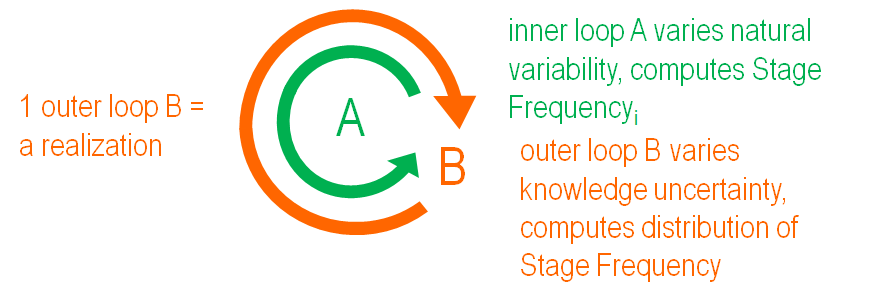Flood Risk Analysis Simulation
USACE flood risk management (FRM) policy requires that USACE analytical processes include methods and tools that employ integrated, comprehensive, systems, lifecycle, and risk-based concepts in planning, design, construction, operations and major maintenance. These USACE methods require incorporation of the systems response of projects when considering load distribution and failure possibilities.
HEC-WAT includes an option that will analyze complex riverine systems while implementing USACE flood risk management and systems requirements. The Flood Risk Analysis (FRA) compute option provides the ability to perform plan formulation or system performance analyses while incorporating risk analysis. The FRA compute option also provides opportunity for any plugin to implement natural variability or knowledge uncertainty sampling through the management of computational seeds provided through the plugin interface with HEC-WAT. The FRA compute in HEC-WAT includes several specialized plugins that fill gaps in typical modeling applications, such as sampling methodologies for hydrology and fragility curves.
Overview
The FRA compute option in HEC-WAT facilitates risk analysis using a nested Monte Carlo simulation approach. Monte Carlo simulation provides a technique for numerical integration where the exact numerical representation of the system is not fully known or things vary naturally. During a Monte Carlo simulation, single-valued inputs (deterministic models) are replaced with randomly sampled values as defined by probability distributions. In turn, the distributions are sampled over and over to span the possible range of model inputs to quantify variability and uncertainty in model results. During an FRA simulation, input values are sampled, algorithmic computations are performed, and summary results are stored.
The FRA compute option allows the model alternatives to evaluate a full range of flood scenarios based on reasonable probabilistic assumptions. The randomly sampled input values, the models involved in the simulation sequence, and the hydrologic loading are all executed iteratively according to the Monte Carlo analysis. At the beginning of each iteration, HEC-WAT generates random numbers (i.e. seeds) which are used by each model alternative in the simulation, with the corresponding software application independently deciding if and how to use those random numbers.
An FRA compute requires a large amount of computational resources and a large amount of storage for results. There are several tools and approaches that users can employ to reduce model runtimes and data storage. For example, HEC-WAT provides model skip flags that that aid in the budgeting of simulation times, based on user criteria. Additionally, a plugin API for generating stratified samples is available. This allows Hydrologic Event Generator plugins to produce stratified events to decrease the computational burden of the Monte Carlo natural variability loop and still properly compute output results.
Random Numbers
HEC-WAT generates pseudo-random numbers as computational 'seeds' for FRA computes. Pseudo-random numbers allow for repeatability of the random sampling when an HEC-WAT alternative is re-computed or between multiple HEC-WAT alternatives. Repeatability is important to support comparison of study alternatives or to restart a simulation at any point in the sequence of numbers. Also, when an event is deemed interesting after the compute is complete, a user can re-run that particular event, saving detailed information for further analysis.
The pseudo-random numbers are generated by a random number generator, which uniquely determines the pseudo-random numbers that are created. Random numbers are generated for each model alternative listed in the program order of a simulation and provided by the plugin through the plugin API. Three sets of pseudo-random numbers are created: one set varies by realization (knowledge uncertainty), another set varies by lifecycle, and the third set varies by event (natural variability). All plugins are provided these pseudo-random numbers, but not all plugins leverage them.
Realizations and Events
The Monte Carlo simulation in the FRA compute is implemented as a two-level nested process so that knowledge uncertainty and natural variability can be evaluated separately.
Knowledge Uncertainty (epistemic uncertainty) describes things we do not know with certainty, but that can be known. For instance, what is the foundation height of a given structure in the structure inventory? A few other examples are flood likelihood, hydraulic coefficients, and channel capacities.
Natural Variability (aleatory uncertainty) describes things that we can not know with certainty, because they vary naturally. For instance, what is the flow in the river going to be on April 3rd next year? Natural variabilities are represented by random variables that vary spatially or event-to-event and exist when the outcome of a natural process is random, or the natural process is so complex it seems random when viewed in isolation. A few examples are flood magnitude and the foundation height of all single family residential structures.
The FRA compute incorporates the two kinds of uncertainty separately by passing separate knowledge and natural variability random numbers for each event. Iterations in the inner loop, called events, are based on randomly sampled natural variability uncertainties. A large grouping of events is collected to create frequency curves and compute probabilistic metrics, through a realization. The outer loop randomly samples the knowledge uncertainty to define uncertainty parameters that are held for all the events in a realization, and thus many realizations express the knowledge uncertainty in our summary results and frequency curves.
